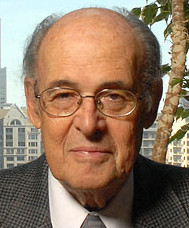We have two very special guests for our readers. Our Persons of the Month are Prof. Ronald Melzack and Prof. Joel D. Katz from Canada.
Prof. Melzack is one of the most influential scientists of modern times. His and Prof. P.D. Wall’s Gate-Control Theory of Pain revolutionized medicine and our understanding of pain. In 1989 Prof. Melzack once more shook the established views of modern medicine when he formulated his Neuromatrix Theory of Pain, which opened new horizons in our understanding of such a complex issue as pain. Our Editorial Board admires the scientific ingenuity and integrity of Prof. Melzack and greatly appreciates that he found time to share with JMS and its readers his wisdom and expertise.
Prof. J. Katz is another world-leading scientist on pain issues. He is Canada Research Chair in Health Psychology, teaches at York University, Toronto, Canada, and is Professor, Department of Anesthesia, University of Toronto. His clinical work is associated with Mount Sinai Hospital and Toronto General Hospital. Prof. Katz is an expert on the Neuromatrix Theory and Prof. Melzack’s co-author.
Here is our interview with the
WORLD’S LEADING PAIN SCIENTISTS


JMS: Please describe the basic concept of Neuromatrix Theory to our readers.
Prof. Melzack and Prof. Katz: In a nutshell, the Neuromatrix Theory of pain proposes that pain is a multidimensional experience produced by characteristic “neurosignature” patterns of nerve impulses generated by a widely distributed neural network in the brain, a network Melzack calls, the “body-self neuromatrix”. These neurosignature patterns may be triggered by sensory inputs, but they may also be generated independently of them.
Pains that are evoked by noxious sensory inputs have been meticulously investigated by neuroscientists, and their sensory transmission mechanisms are generally well understood. In contrast, chronic pain syndromes, which are often characterized by severe pain associated with little or no discernible injury or pathology, remain a mystery. Note that this scenario involves first and foremost, searching for the peripheral factors and the peripheral triggers that, in any given patient, are contributing to the pain problem.
The Neuromatrix Theory of pain provides a new conceptual framework. It proposes that the output patterns of the neuromatrix activate perceptual, homeostatic and behavioral programs after injury or pathology, or as a result of multiple other inputs that act on the neuromatrix. Pain, then, is produced by the output of a widely distributed neural network in the brain rather than directly by sensory input evoked by injury, inflammation or other pathology. This does not mean that these sensory inputs are unimportant to the generation of pain: in most cases they are the triggers that activate the neuromatrix. The neuromatrix, which is genetically determined and modified by sensory experience, is the primary mechanism that generates the neural pattern that produces pain. Its output pattern is determined by multiple influences, of which the somatic sensory input is a part.
JMS: From various Internet posts and letters from our readers, we have noticed that some somatic practitioners believe that the Neuromatrix Theory of Pain, which was developed by Professor Melzack, nullifies the Gate-Control Theory of Pain developed by Prof. Melzack and Prof. Wall in 1965. Would you say that this is the correct perspective to bear?
Prof. Melzack and Prof. Katz: Certainly not. As your readers will be aware, the Gate Control Theory of Pain highlighted the role of spinal and brain mechanisms in acute and chronic pain. However, as historians of science have noted, good theories are instrumental in generating new hypotheses and new data that eventually require a new theory. And this is what has happened with the Gate Control Theory of Pain.
It is possible to make adjustments to the gate control theory so that, for example, it includes long-lasting activity. However, there is a set of observations on pain in paraplegics that just does not fit the theory. This does not negate the gate theory, of course (bold by JMS). Peripheral and spinal processes are obviously an exceedingly important part of pain, and we need to know more about the mechanisms of peripheral inflammation, muscle spasm, nerve injury, spinal modulation, midbrain descending control, and so forth. However, the data on painful phantoms below the level of total spinal section indicate that we need to go beyond the foramen magnum and into the brain.
JMS: Is it accurate to say that the important component, which separated the Gate Control Theory of Pain from other theories at the time, was the fact that from very beginning Prof. Mezlack and Prof. Wall had recognized the brain as an active participant in pain perception rather than being a simple receiver of noxious stimuli from the peripheral receptors?
Prof. Melzack and Prof. Katz: As we have noted in the past, and alluded to above, theories of pain, like all scientific theories, evolve as a result of the accumulation of new facts as well as leaps of the imagination. The Gate Control Theory’s most revolutionary contribution to understanding pain was its emphasis on central neural mechanisms. The theory forced the medical and biological sciences to accept the brain as an active system that filters, selects, and modulates inputs. The dorsal horns, too, were not merely passive transmission stations but sites at which dynamic activities- inhibition, excitation, and modulation – occurred.
The Gate Control Theory’s emphasis on the modulation of inputs in the spinal dorsal horns and the dynamic role of the brain in pain processes had a clinical as well as a scientific impact. Psychological factors that were previously dismissed as “reactions to pain” were, more accurately, seen to be an integral part of pain processing and new avenues for pain control by psychological therapies were opened. Similarly, cutting nerves and pathways was gradually replaced by a host of methods to modulate the input. Physical therapists and other health-care professionals who use a multitude of modulation techniques were brought into the picture, so that TENS and massage therapy became important modalities for the treatment of chronic and acute pain.
JMS: In our understanding, Neuromatrix Theory covers the central mechanism of pain generation. Does Neuromatrix Theory also recognize the existence of a peripheral origin of pain in the form of an injury (e.g. Lateral Epycondylitis or Tennis Elbow) or chronic overload (e.g. active Trigger Point in the skeletal muscle) as an initial trigger for the activation of the pain-analyzing system?
Prof. Melzack and Prof. Katz: Absolutely. It would be an error to assume that peripheral factors such as those you mention, and others, are unimportant to the experience of pain and to the Neuromatrix Theory. Moreover, in our opinion, to ignore or downplay a peripheral trigger by pointing to the Neuromatrix theory as evidence that these factors don’t play in pain a role is akin to “putting the cart before the horse”.
It is essential to do a thorough physical examination and to search for the peripheral triggers and peripheral pathology that contribute to pain. To do otherwise is poor clinical practice and unethical (bold by JMS). Moreover, it does a disservice to the patients we treat because it discounts their experience and symptoms by suggesting that the periphery is not important. The kinds of observations that led Dr. Melzack to develop the Neuromatrix Theory, such as painful phantoms below the level of a total spinal section, pointed to the necessity of moving beyond the periphery and spinal cord and into the brain. Note however, that in these cases, the role of the periphery had in fact been ruled out. But to claim that because peripheral factors or triggers are not necessary for pain to be experienced after complete spinal cord transection, the periphery is not involved in ALL pains is faulty logic and clearly not true.
JMS: The article Prof. Melzack and you published in Wiley Interdisciplinary Reviews, also addresses the implications of Neuromatrix Theory for cases of Lower Back Pain and Fibromylagia. Some somatic practitioners have made the conclusion that local treatments of the affected areas using various methods and techniques are the wrong way to treat these and other somatic abnormalities since the brain itself is the sole generator of the pain. From our perspective the position that you and Prof. Mezlack hold is that there is supposed to be an integrative approach to pain management where the central and peripheral components are equally addressed. Is this the correct understanding of your ideas?
Prof. Melzack and Prof. Katz: The Neuromatrix Theory postulates that pain is a psychological experience, that the origins of the patterns that underlie the qualities of experience are in neural networks in the brain, and that pain can, therefore, be generated in the absence of peripheral injury or a peripheral trigger. But as noted above, this should not be taken to mean that all experiences of pain are independent of peripheral input and that peripheral factors cannot be the triggers of the brain activity that produces pain. As we have pointed out above, peripheral input is neither a necessary nor a sufficient condition for pain to be experienced but this does not mean that peripheral input never contributes to pain; in fact more often than not it is involved in the pain experience.
JMS: What advice do you have for our readers who deal with somatic pain on daily basis?
Prof. Melzack and Prof. Katz: Our advice is to do a thorough physical examination, to look for the peripheral factors that may be triggering the pain, and to treat them as they are identified. If the pain does not resolve within an appropriate time, refer the patient for additional assessment. At the same time, we suggest managing the psychological and emotional contributions to the pain experience. Many patients are afraid, worried, anxious, and otherwise distressed by their pain. This is natural. These thoughts and feelings can contribute to the pain experience by making it more intense and more troublesome.
For example, when pain becomes chronic, anxiety and fear are often accompanied by avoidance and escape behaviors which lead to disuse and disability. Patients with chronic pain may fear that activity will cause a flare-up in pain or that they will get re-injured. They understandably avoid the activities that they believe will cause these feared outcomes. The problem with avoidance is that the patient never tests out the possibility that activity will not cause pain and so the avoidance behaviours and the anxiety are positively reinforced and maintained. Appropriately timed and paced activity can be reintroduced to combat the avoidance that is maintaining the fear and anxiety.
Such an integrative approach to pain management where the central and peripheral components are equally addressed is essential. However, the present emphasis on the psychological aspects of pain management should not be taken to mean that psychological dysfunction is the cause of the pain. The faulty logic outlined above regarding the supposed unimportance of peripheral inputs to pain experience often goes hand-in-hand with this misconception. The idea that peripheral input is not a necessary condition for pain to be experienced is frequently used as “evidence”, especially in a distressed patient, that the pain must therefore be “psychogenic” or caused by psychopathology. This is also clearly wrong (bold by JMS).
Gagliese L, Katz J. Medically-unexplained pain is not caused by psychopathology. Pain Res Manage. 2000;5(4):251-257
McMahon SB, Koltzenburg M, Tracey I, Turk DC, eds. Wall & Melzack’s textbook of pain. 6th ed. New York: Churchill-Livingstone; 2013
Melzack R, Katz J. Pain in the 21st century: The neuromatrix and beyond. In: G. Young, A. Kane, Nicholson K, eds. Causality: Psychological knowledge and evidence in court. New York: Springer; 2006:129-148
Melzack R, Katz J. Pain. WIREs Cogn Sci. 2013;4:1-15
Melzack R, Loeser JD. Phantom body pain in paraplegics: evidence for a central “pattern generating mechanism” for pain. Pain. Feb 1978;4(3):195-210
Melzack R, Wall PD. Pain mechanisms: a new theory. Science. Nov 19 1965;150(3699):971-979
Category: Letter From The Editor
